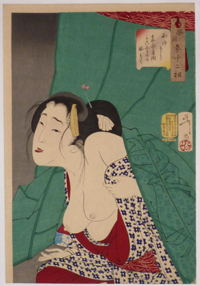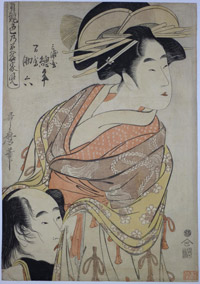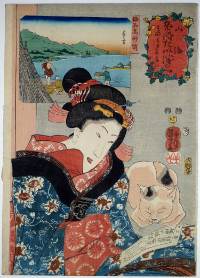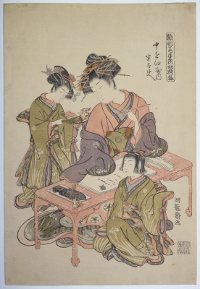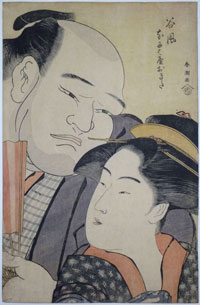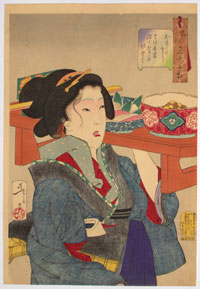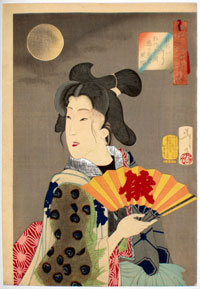/category/beauties/page/6/
Tsukioka YOSHITOSHI (1839-1892)
Click here to view image full size.
Looking Itchy: The Appearance of a Kept Woman of the Kaei Era ( 1848 – 1854 ). From the set: Thirty-two Aspects of Women published by Tsunashima Kamekichi, 1888. Shows a dishabille beauty emerging from a mosquito net. One of the two or three best designs from the set.
Fine impression of the first edition. Fine colour and condition with the extra paper at left edge and the full handling area showing bottom right. Signed Yoshitoshi ga.
Status: Sold
Tsukioka YOSHITOSHI (1839-1892)
Click here to view image full size.
Looking Itchy: The Appearance of a Kept Woman of the Kaei Era ( 1848-1854 ). From the set Thirty-two Aspects of Women published by Tsunashima Kamekichi, 1888. Shows a dishabille beauty emerging from a mosquito net. One of the two or three best designs from the set.
Very fine impression, colour and condition. Pristine. The first edition. Signed Yoshitoshi ga.
Status: Sold
Kitagawa UTAMARO (1753-1806)
Click here to view image full size.
An aiban print: Junidan hana no nishiki, “Twelve Chapters of Floral Brocades” from Seiro Niwaka zensei asobi, “Most Splendid Entertainment of the Niwaka Festival in the Licensed Quarters.” The Festival was held in September in the Edo Yoshiwara district. Shows Minamoto no Yoshitsune visiting Princess Joruri. Not listed in Yoshida or Shibui, Ukiyoe zuten, although another version is in Yoshida, Utamaro zenshu on page 162. Published c 1802 by Yamashiroya Toemon.
Fine impression, colour and condition. Perfect colour. Signed Utamaro hitsu.
Status: Sold
Yushido SHUNCHO (Fl. C 1780-95)
Click here to view image full size.
A chuban print showing beauties sight-seeing on the Sumida River. From a set of ten prints of views of Koto ( an area of Edo bounded by the Sumidagawa to the west and Arakawa to the east ). Published by Enomoto, c 1790.
Very good impression. Exceptionally well preserved colour: the fugitive pigments intact. Very slight soil, otherwise very good condition. Full size.
Status: Sold
Kitagawa KIKUMARO (Fl. c. ? – 1830)
Click here to view image full size.
Ryogoku Bridge from a set: Edo meisho mitate ju kei, “A Parody of Ten Famous Places in Edo.” Shows pleasure boats cooling off between the trestles of the bridge. The Ryogoku was often depicted by Hiroshige and other artists, especially with fireworks over the bridge to celebrate the “Opening of the River” on the 28th day of the 5th month. Published by Yamashiroya Tokei (?), c. 1803. Ex Hayashi collection, sealed bottom right.
Very good impression, colour and condition. Signed Kikumaro hitsu. ( Kikumaro signed thus between 1795 – 1805. )
Status: Sold
Tsukioka YOSHITOSHI (1839-1892)
Click here to view image full size.
Looking Tiresome: The Appearance of a Virgin of the Kansei Era ( 1789 – 1802 ). From the set: Thirty-two Aspects of Women published by Tsunashima Kamekichi, 1888. The young girl strokes a pet cat.
Very fine impression of the first edition with the cat’s fur strongly blind-printed. Fine colour. Miniscule trimming on left, otherwise very good condition. Signed Yoshitoshi ga.
Status: Sold
Utagawa KUNICHIKA (1835-1900)
Click here to view image full size.
A young girl seated to have her photograph taken, the plate camera with dark cloth draped over, to the right. From a series Kaika ninjo kagami, “A Mirror of Modern Manners and Customs, ” sub-title “Photographs.” Photography took off quickly in Japan and there were a considerable number of photographic studios in Tokyo in the 1870’s. However, there are only a few prints as early as this showing cameras. Published 1878.
Very fine impression with extensive burnishing. Fine colour. Minor trimming and light album backing. Signed Toyohara Kunichika fude.
Status: Sold
Kitagawa UTAMARO (1753-1806)
Click here to view image full size.
The lovers Miuraya Agemaki and Yorozuya Sukeroku from the set: Jitsu kurabe iro no minakami, “True Feelings Compared: The Founts of Love.” A series of half-length portraits from joruri love-suicide plays with the addition of several other famous couples. This design depicts a scene from the second half of a “Sukeroku” play showing the hero Yorozuya no Sukeroku and the courtesan Agemaki from the Shimabara quarter: Sukeroku kills Ikyu, steals the heirloom sword Tomokiri-maru and the two lovers escape after Sukeroku gets soaked hiding in a water butt, and then being hidden in the voluminous surcoat of Agemaki [ as shown here ]. The set published c 1798-9 by Nishimuraya. Ex collection Adolphe Stoclet, sold Sothebys 2004, lot 239, p. 139. Bought from Murakami 17/6/1908. Other impressions: Vever, Part 1, 1974, lot 197, p. 168 ( trimmed ); Shibui, Zuten, p. 110, no. 8; Yoshida, Utamaro, 1941, no. 365; TNM, vol. 2, no. 1896. Unidentified collector’s seal bottom right.
Very good impression and colour. Slightly trimmed at top and minimally at bottom. Small edge repair. Signed Utamaro hitsu.
Status: Sold
Utagawa KUNIYOSHI (1797-1861)
Click here to view image full size.
A beauty having taken a bath wears a loose fitting yukata with a tenugui slung over one shoulder. She is about to brush her teeth. From Kuniyoshi’s finest set of fan prints. An untitled series of at least six designs showing young women in a state of dishabille at their toilette in front of mirrors, the corners partly concealed with cloth covers. Published c 1843-5 by Ibaya Sensaburo. For obvious reasons, uncut uchiwa-e are scarce. Indeed, this example might be unique. The other known prints from this rare set are: 1) A beauty powdering her face; 2) A beauty shaving her forehead; 3) A beauty suckling a child; 4) A beauty adjusting her hair with scissors; 5) A beauty playing with a cat.
Very good impression and colour. Slight soil top and bottom right corners, otherwise good condition. Uncut. The rich blue grounds on this series have added mica. Signed Cho-o-ro Kuniyoshi ga.
Status: Sold
Utagawa KUNIYOSHI (1797-1861)
Click here to view image full size.
A vertical diptych of a salt-water gatherer. These girls are often depicted in ukiyoe and seem to have held a fascination with the public akin to that for ama divers. Published by Jimpachi, c 1840.
Very good impression and colour. Sheets separated. Minor signs of being mounted around edge, otherwise good condition. ( These vertical diptychs of this date and earlier were usually mounted onto inexpensive paper mounts. A poor man’s version of kakemono paintings. ) Signed Cho-o-ro Kuniyoshi ga.
Status: Sold
Kitagawa UTAMARO (1753-1806)
Click here to view image full size.
No. 7 from a set of 12 prints: Joshoku kaiko tewazagusa, showing women engaged in the sericulture (silkworm) industry. This was traditionally the domain of women. The colour scheme is red-avoiding (murasaki-e) using predominantly purple. This stage of the process shows the metamorphosis – the winged moth stage – when silkworms are used to lay eggs. This set is taken verbatim from the Shunsho/Shigemasa set of chuban prints, Kaiko yashinai-gusa. (See elsewhere on this site for a Shunsho example.) Published 1798-1800 by Tsuru-ya Kiemon.
Fine impression. Fine colour, perfectly retained. Very good condition; full size. Signed Utamaro hitsu.
Status: Sold
Utagawa KUNIYOSHI (1797-1861)
Click here to view image full size.
A beauty in sumptuous clothing from a fine set of seventy numbered prints with title: Sankai medetai zu, “Excellences of Mountain and Sea.” The set compares busts of beautiful women with various products and occupations from the provinces of Japan. This is number 3, Tamba, and shows men fishing at night with the aid of flares. The set published 1852 by Sano-ya Kihei.
Very fine impression and colour with strong burnishing on collar. Fine condition. Signed Ichiyusai Kuniyoshi ga.
Status: Sold
Utagawa KUNIYOSHI (1797-1861)
Click here to view image full size.
A beauty reading a program while a cat dozes beside her. From a fine set of seventy numbered prints with title: Sankai medetai zu, “Excellences of Mountain and Sea.” The set compares busts of beautiful women with various products and occupations from the provinces of Japan. This is number 19. Catching octopuses, Takasago in Banshu [Harima] Province. The set published 1852 by Sano-ya Kihei.
Very good impression and colour. The cat’s fur blind-printed. Light album backing, otherwise good condition. Signed Ichiyusai Kuniyoshi ga.
Status: Sold
Keisai EISEN (1790-1848)
Click here to view image full size.
The courtesan Hanaoka of the Sanomatsuya House in the Shin Yoshiwara looking out at the rain and holding a poem slip. Episode Amagoi from a Seven Komachi set: Shin Yoshiwara yugimi nana Komachi. The set based on the seven episodes in the life of the famous 9th century poetess Ono no Komachi. Published by Tsuta-ya, c 1830.
Very good impression. This is the first state with gradation in the sky and at the end of Hanaoka’s robe. Superb, unfaded colour. Fine condition; full size. Signed Keisai Eisen ga.
Status: Sold
Kitao SHIGEMASA (1739-1820)
Click here to view image full size.
A chuban print. No. 7 from Kaiko yashinai gusa, the occupation of silk worm cultivation. Shows girls watching the moths laying eggs on a piece of paper. No publisher given but published 1772. Even better known as a book illustrator. Also an accomplished painter.
Fine impression. Very good colour. Fine condition. Signed Shigemasa ga.
Status: Sold
Isoda KORYUSAI (Active c 1764-1788)
Click here to view image full size.
The courtesan Handayu of Naka-Omiya seated at a writing desk attended by two accolytes. From a superb, large series: Hinagata wakanano hatsu moyo, “Models for Fashion: New Year Designs as Fresh as Young Leaves.” Published by Nishimura Eijudo, c 1776-7. Yoshida catalogues this set in Ukiyo-e, no. 26. A beautiful deluxe print.
Superb impression on thick hosho. Very slight fading of red and expertly repaired binding holes near left edge, otherwise very good condition. Koryusai ga.
Status: Sold
Chokosai EISHO (active 1790s)
Click here to view image full size.
An aiban showing the seated courtesan Somenosuke of Matsubaya reading a hand scroll. From the set Kakuchu bijin-kisoi, “Three Patron Saints of Poetry in the Gay Quarters.” Eisho was the most successful of Eishi’s pupils. Published c 1790s by Yamaguchi Chusuke. Another from the set illustrated in A Treasury of Japanese Wood Block Prints, Sadao Kikuchi, no 694. Illustrated in Ukiyo-e Taikei, vol. 6, no. 216.
Very good impression and colour. Thinned area top border, otherwise very good condition. Signed Eisho ga.
Status: Sold
Torii KIYONAGA (1752-1815)
Click here to view image full size.
A chuban print showing two geisha, one seated with a loose yukata, the other standing beside her. Choka no sekisho, “The Afterglow of Late Summer” from an early set: Shiki hakkei, “Eight Scenes of the Four Seasons.” Published 1779 by Eiju han. Illustrated in Images of Eighteenth-Century Japan, David Waterhouse, ROM, 1975, no. 95, p. 149 and Hirano, Kiyonaga, Museum Of Fine Arts, Boston, 1939, no. 185 and pl. XVI. ( Chie Hirano is the standard source on Kiyonaga and she illustrates the complete set. )
Fine impression. Some “turning” of colours, otherwise very good condition. Signed Kiyonaga ga.
Status: Sold
Ippitsusai BUNCHO (1763-1840)
Click here to view image full size.
A chuban print showing a beauty standing on a balcony adjusting a comb in her hair. She gazes at a ferry crossing the Sumida River in rain. One of a series with title on an ink-cake top right: Bokusui hakkei, “Eight Views of Inky Water” ( “Inky Water” being the colloquial term given to the Sumida River ); sub-title: Hashiba no yora no ame, “Evening Rain at Hashiba.” Ex Gonse collection, first sale, no. 13, pl. 2 ( seal au verso ) and Vever collection, Sotheby & Co, Part II, 1975, lot 101 ( seal bottom right ). Extremely rare. A much trimmed impression is in T.N.M., vol. 1, no. 827.
Fine impression. Some “turning” of colours, otherwise very good condition. Signed Ippitsusai Buncho ga with Mori uji seal.
Status: Sold
Isoda KORYUSAI (Fl. c 1764–1788)
Click here to view image full size.
A chuban print entitled Yu, “Evening,” showing the courtesan Matsushita of Matsubaya with two acolytes. Koryusai was an ex samurai. Well known for excellent and rare kacho and some fine hashira-e. Published c early 1770s. Ex collection Paul-Louis de la Noe, 1879-1919, ( an acquaintance of the Goncourt brothers, Bing and Hayashi ). Rare.
Fine impression. Fine well retained fugitive pigments. Slight soil at bottom, otherwise very good condition. Signed Koryu ga.
Status: Sold
Nishimura SHIGENAGA (1697 ? –1756)
Click here to view image full size.
The centre sheet of a triptych: Sampuku –tsui, Yashiki fu, “A set of Three Prints in the Style of a Grand House.” Shows a young beauty holding a wooden box, a sprig of cherry blossom and a flower in a paper holder. An important artist, teacher and innovator. Urushi-e, coloured by hand: Beni, mustard, yellow and blue with extensive gold powder and heavy lacquered sumi over embossed lines. Published c 1730 by Hammoto, Motohama-cho, Iga-ya. Ex collection Walter von Scheven, 1878 – 1950, and purchased by him from Altkunst, Berlin in 1925. Illustrated as frontispiece in J. Kurth, Die Primitiven des Japanholzschnitts, Dresden, 1922. A beautiful example of the artist’s work. A beautiful and extremely rare print.
Fine impression. Very slight soil and edge repaired wormage, otherwise very good condition. Signed Nihon gako Nishimura Shigenaga hitsu.
Status: Sold
Katsukawa SHUNCHO (Active c 1780–1795)
Click here to view image full size.
A double okubi-e showing the sumo wrestler Tanikaze juxtaposed to the oiran Okita. A superb composition. Of the utmost rarity: Another impression is illustrated in V. & I., 1911, no. 231, pl. LI, SCI/224. Impressions of the companion print, showing Onogawa and Takashima Ohisa are catalogued in Hillier, Japanese Prints & Drawings From The Vever Collection, Volume Two, Sothebys 1976, no. 519, p. 497; Tokyo National Museum, TNM, vol. 2, no. 1722, and British Museum ( illustrated Hillier, Japanese Masters of the Colour Print, 1954, pl. 56 ). Published by Tsuruki c 1792. Ex collection Walter von Scheven, 1878 – 1950, and bought by him from Heinrich Tiedemann, Berlin in 1927.
Very good impression and colour. Light yellow ground. Very minor soil, otherwise extremely good condition. Probably the best copy extant. Signed Shuncho ga.
Status: Sold
Eishosai CHOKI (Active c 1780–1810)
Click here to view image full size.
An elegant young entertainer beside her samisen box. Top left is a ballad that she presumably sang. While producing some mundane work, Choki also designed some of the most exquisite ukiyoe. Extremely rare: Another impression is illustrated in the Catalogue of Inaugural Exhibition of Riccar Art Museum, no. 42 and a second example is in the Tokyo National Museum, illustrated in A Treasury Of Japanese Wood Block Prints, Sadao Kikuchi, 1968, no. 640. Published by Tsuruya Kiemon, c 1795. Ex collection Walter von Scheven, 1878 – 1950, and purchased by him at Alfred Kappes, Ludwigshafen in 1925.
Fine impression. Very slight fading and minor fold marks, otherwise very good condition. Signed Choki ga.
Status: Sold
Tsukioka YOSHITOSHI (1839-1892)
Click here to view image full size.
“Looking Weighed-down: The Appearance of a Waitress at Fukagawa in the Tempo Era” ( 1830 – 1844 ). From the set: Thirty-two Aspects of Women published by Tsunashima Kamekichi, 1888. The waitress is shown carrying a tray of rice, sashimi and beans.
Very fine impression and colour of the first edition. A mulberry fibre towards top edge, otherwise very fine condition with margins intact. ( These thread-like filaments of the tree sometimes survived the pulping process – either minute pieces of the outer or inner bark and are often seen. ) Signed Yoshitoshi ga.
Status: Available
Kikugawa EIZAN (1787-1867)
Click here to view image full size.
A double bust portrait showing the courtesans Takigawa and Hanaogi from the Yoshiwara house Ogiya. An early print ( Eizan being 21 ) published 1808 by Kikakudo. Rare.
Fine impression. Fine, totally unfaded colour. Slight browning and light creasing. Full size. Signed Kikugawa Eizan hitsu.
Status: Sold
Utagawa KUNICHIKA (1835-1900)
Click here to view image full size.
A young girl seated to have her photograph taken, the plate camera with dark cloth draped over, to the right. From a series Kaika ninjo kagami, “A Mirror of Modern Manners and Customs,” sub-title “Photographs.” Photography took off quickly in Japan and there were a considerable number of photographic studios in Tokyo in the 1870’s. However, there are only a few prints as early as this showing cameras. Published 1878.
Very fine impression with extensive burnishing. Fine colour. Minor trimming and light album backing. Signed Toyohara Kunichika fude.
Status: Sold
Kubo SHUNMAN (1757–1820)
Click here to view image full size.
Mishima, or Toi, Province of Settsu. The best design from an exquisite set of six prints showing graceful young women, girls and, in two instances, young men representing the Six Crystal ( Tama ) Rivers. These streams were noted for the purity of their water. The prints are in benigirai style, “red avoiding”, a technique pioneered by Shunman, Eishi and Shuncho. Shows a seated girl fulling cloth ( hence Toi which is the alternative name of the river and the word for beating cloth ) with three other beauties near the village of Mishima. A light shower passes by in the background. Shunman, a man of great sophistication, designed only a few prints before concentrating on surimono and printing and issuing some of the finest in this format. ( See The Japanese Print A New Approach, J. Hillier, pp. 102 – 104: “Probably no artist except Choki has achieved so high a reputation on such a small number of prints.” ) He also excelled at painting, book illustration and light verse. Published by Fushimiya Zenroku, c 1787. ( A later edition was issued by Tsutaya with less harmonious colours. ) One of the most beautiful 18th century sets, and together with a night triptych showing people returning from a poetry reading, is considered his masterpiece. Rare.
Fine impression. The centre female’s kimono blind-printed. Very good colour: printed only in tones of grey, light yellow and light pink, with touches of light red on the tree’s leaves. Very small repaired wormhole, otherwise extremely good condition with extra paper at left. Probably untrimmed ( whereas illustrated examples all seem to be trimmed somewhere ). Signed Shunman with seal Shunman.
Status: Sold
Kubo SHUNMAN (1757–1820)
Click here to view image full size.
Chobu, Province of Musashi from an exquisite set of six prints showing graceful young women, girls and, in two instances, young men representing the Six Crystal ( Tama ) Rivers. These streams were noted for the purity of their water. The prints are in benigirai style, “red avoiding”, a technique pioneered by Shunman, Eishi and Shuncho. Shows a girl washing stripes of cloth in the stream. In fact, this design conjoins with the following in the set of six prints. Shunman, a man of great sophistication, designed only a few prints before concentrating on surimono and printing and issuing some of the finest in this format. ( See The Japanese Print A New Approach, J. Hillier, pp. 102 – 104: “Probably no artist except Choki has achieved so high a reputation on such a small number of prints.” ) He also excelled at painting, book illustration and light verse. Published by Fushimiya Zenroku, c 1787. ( A later edition was issued by Tsutaya with less harmonious colours. ) One of the most beautiful 18th century sets, and together with a night triptych showing people returning from a poetry reading, is considered his masterpiece. Rare.
Fine impression with some blind printing. Very good colour: printed only in tones of grey, light yellow and light pink, with touches of light red on the tree’s leaves. Very small repaired wormhole, otherwise extremely good condition with extra paper at left. Probably untrimmed ( whereas illustrated examples all seem to be trimmed somewhere ). Signed Shunman with Shunman seal.
Status: Sold
Utagawa TOYOKUNI I (1769–1825)
Click here to view image full size.
An extremely fine triptych showing beauties and families outside the famous dry goods store Ebisuya. ( Two roundels with the shop’s symbol Ebisu – one of the Seven Gods of Good Luck – are on either side of the entrance. ) Besides the elegance of the figures, there is an added anthropological perspective as we can view the crowds of customers inside the building. Presumably Ebisuya was the prime motivator in getting this print published. Another impression ( ex Spaulding collection ) is in the Museum of Fine Arts, Boston, accession number: 21.7744. Published by Takasu Soshichi, c 1795. Very rare.
Fine impression with exceptionally well preserved colour. One small area affected by damp, otherwise in remarkably fine condition. Full size. Signed Toyokuni ga.
Status: Sold
Kitagawa UTAMARO (1753-1806)
Click here to view image full size.
Tamaya-nai Tagasode, The courtesan Tagasode of the Tamaya House. She is shown floating a model boat in a Chinese vessel. An extremely elegant composition. Published c. 1800 – 1804. Unidentified publisher’s seal. Apparently not listed in the standard Utamaro reference works.
Fine impression. Virtually unfaded with the fugitive lilac pigment on the geisha’s costume intact. Expertly repaired wormhole above signature and minor crease to the right of figure, otherwise extremely good condition. Full size. Signed Utamaro hitsu.
Status: Sold
Kochoro KUNISADA (1786-1865)
Click here to view image full size.
A secret tryst with a young woman, her face partially hidden, opening a sliding screen which lets a beam of light illuminate the darkness. From a set of six prints: Secret Meetings by Moonlight, Tsuki no kage shinobiau yoru. A fine set published c. 1836 – 38 by Yamamoto Kyubei ( second edition Izumiya Ichibei ).
Fine impression and colour. Minor edge soil, otherwise very good condition. Signed Kochoro Kunisada ga.
Status: Sold
Kikugawa EIZAN (1787-1867)
Click here to view image full size.
A picnic party visiting the famous cherry tree at Naruko in the city, Miyako meibonku naruko no sakura. Poems are being written and attached to the branches. An extremely early design ( published 1807 ).
Fine impression. Very good colour. Some trimming around thereby loosing part of signature on two sheets. Signed Kikugawa Eizan fude.
Status: Sold
Kubo SHUNMAN (1757-1820)
Click here to view image full size.
Mishima, or Toi, Province of Settsu. The best design from an exquisite set of six prints showing gracefull young women, girls and, in two instances, young men representing the Six Crystal ( Tama ) Rivers. These streams were noted for the purity of their water. The prints are in benigirai style, “red avoiding”, a technique pioneered by Shunman, Eishi and Shuncho. Shows a seated girl fulling cloth ( hence Toi which is the alternative name of the river and the word for beating cloth ) with three other beauties near the village of Mishima. A light shower passes by in the background. Shunman, a man of great sophistication, designed only a few prints before concentrating on surimono and printing and issuing some of the finest in this format. ( See The Japanese Print A New Approach, J. Hillier, pp. 102 – 104: “Probably no artist except Choki has achieved so high a reputation on such a small number of prints.” ) He also excelled at painting, book illustration and light verse. Published by Fushimiya Zenroku, c 1787. ( A later edition was issued by Tsutaya with less harmonious colours. ) One of the most beautiful 18th century sets, and together with a night triptych showing people returning from a poetry reading, is considered his masterpiece. Rare.
Fine impression. The centre female’s kimono blind-printed. Very good colour: printed only in tones of grey, light yellow and light pink, with touches of light red on the tree’s leaves. Minor marks, otherwise very good condition. Probably untrimmed ( whereas illustrated examples all seem to be trimmed somewhere ). Signed Shunman with Shunman seal.
Status: Sold
Kochoro KUNISADA (1786-1865)
Click here to view image full size.
Three beauties returning home on a summer evening after having been to the bathhouse, probably in the vicinity of the Daimyojin, Edo. The third woman’s angled lantern illuminates the whole scene, the background figures in pure silhouette. Kunisada designed an earlier version of this subject signed Gototei in the early 1820s. This version published c 1845-1847. This must have been a popular print as poor impressions exist.
Very good impression and colour. Minor edge wormage repaired, otherwise very good condition. Signed Kochoro Toyokuni ga.
Status: Sold
Katsukawa SHUNSHO (1726-1792)
Click here to view image full size.
An excessively rare wide hashira-e ( 27.5 x 6.5 in.; 70 x 16.5 cms. ) showing a full length courtesan. The only other impression ( heavily trimmed ) I can locate is illustrated in an unpublished manuscript by Frederick William Gookin, The Life And Works of Katsukawa Shunsho, from the Clarence Buckingham collection ( C.B. AI 7 ). Published c late 1750s. No publisher’s seal.
Very good impression. Probable fading but with nothing to compare with ( the illustration in Gookin is a poor b.& w. image ) it’s difficult to tell. Slight weakening along laid lines ( as per usual ) and some slight marks. Generally very good condition considering size and date. Signed Shunsho ga.
Status: Sold
Ishikawa TOYONOBU (1711-1785)
Click here to view image full size.
An extremely rare design showing a young woman either opening or closing an umbrella. She wears a rain-cape and high clogs ( geta ). Toyonobu’s hashira-e are amongst his most accomplished works. There appear to be at least three other known impressions: A.D.Ficke, Chats on Japanese Prints, pl.8 ( ex Metzgor coll. ); H.C.Gunsaulus, Japanese Prints of the Clarence Buckingham Collection, Volume I, AIC, 1955, no.16, p.206; and James A. Michener, Japanese Prints, no.78, p.75. There is some confusion as the Michener example appears to be the same impression from various well known collectors and illustrated in different places ( eg M. Bullier collection, illustrated in V.& I, volume I-III, pl.LIII ). Wide hashira-e ( 27.5 x 5.5 in.; 70 x 14 cms. ) Coloured by hand with beni ( overlaid with urushi ), yellow, mustard, brown and blue. Published c 1742 by Urokogata-ya. A beautiful print.
Very good impression. Some toning ( as per usual ), and slight weakening along laid lines ( as per usual ). Trimmed slightly at left. The colours particularly well retained. Signed Tanjodo Ishikawa Shuha Toyonobu zu.
Status: Sold
Ichiryusai HIROSHIGE (1797-1858)
Click here to view image full size.
Full moon at Takanawa. A bijin seated beside her palanquin at a tea house. A mitate set: Edo Murasaki meisho Genji, “Murasaki’s Genji in Famous Places of Edo.” Based on the Genji Monogatari with stylised clouds above and below in Yamato-e style. Published by Kinseido c1849-53. A very rare set: Late impressions being unknown.
Fine impression and colour. Light crease in left and right margin, otherwise fine
condition. Signed Hiroshige ga.
Status: Sold
Tsukioka YOSHITOSHI (1839-1892)
Click here to view image full size.
“Looking Suitable: The Appearance of a Brothel Geisha of the Koka Era” ( 1844-1848 ). From the set: Thirty-two Aspects of Women published by Tsunashima Kamekichi, 1888.
Very fine impression, colour and condition of the first edition. This design is difficult to find in good condition as the [ oxidised ] silver of the first edition on the peacock feathers invariably migrates to other parts of the design, especially if it comes from an album. Signed Yoshitoshi ga.
Status: Sold
Ichiyusai KUNIYOSHI (1797-1861)
Click here to view image full size.
An uchiwa-e ( fan print ) showing a young girl leaning over the side of a boat and wetting a towel. “Cool” from a set of six prints: Imayo rokkasen, “Six Modern Choises for Summer”. Published 2/1853. Unidentified publisher.
Superb impression, colour and condition. Signed Ichiyusai Kuniyoshi ga.
Status: Sold
Tsukioka YOSHITOSHI (1839-1892)
Click here to view image full size.
Looking chilly: The appearance of a concubine of the Bunka Era ( 1804 – 1818 ). From the set: Thirty – two Aspects of Women published by Tsunashima Kamekichi, 1888.
Very fine impression of the first edition. Fine colour and condition. Signed Yoshitoshi ga.
Status: Sold

